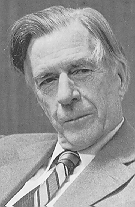| Profile | Major Works | Resources |
John Kenneth Galbraith, 1908-2006


The Canadian-born John Kenneth Galbraith has been considered by many as the "Last American Institutionalist". As a result, Galbraith has remained something of a renegade in modern economics - and his work has been nothing if not provocative.
Raised on a small farm in rural Ontario, John Kenneth Galbraith studied at Ontario Agricultural College, and then went moved to the United States to study agricultural economics at UC Berkeley, receiving his Ph.D. in 1934. Galbraith joined the Harvard faculty as instructor in agricultural economics in 1936. During WWII, now a naturalized US citizen, Galbraith moved to Washington DC to become a deputy chief of the Office of Price Administration (1941-43). After a series of other government missions, Galbraith returned to Harvard in 1948.
In the 1950s, Galbraith presented economics with two tracts that needled the mainstream: one developing a theory of price control (which arose out of his wartime experience in the Office of Price Administration) which he argued for as an anti-inflation policy (1952); the second, American Capitalism (1952), which argued that American post-war success arose not out of "getting the prices right" in an orthodox sense, but rather of "getting the prices wrong" and allowing industrial concentration to develop. It is a formula for growth because it enables technical innovation which might otherwise not been done. However, it can only be regarded as successful provided there is a "countervailing power" against potential abuse in the form of trade unions, supplier and consumer organizations and government regulation. Many have since argued the formula for East Asian success later in the century was based precisely on this combination of oligopolistic power and "countervailing" institutions.
It was his smallish 1958 book, The Affluent Society, that earned Galbraith his popular reknown and professional emnity. Although the thesis was not astoundingly new - having long been argued by Veblen, Mitchell and Knight - his attack on the myth of "consumer sovereignty" went against the cornerstone of mainstream economics and, in many ways, the culturally hegemonic "American way of life".
His New Industrial State (1967) expanded on Galbraith's theory of the firm, arguing that the orthodox theories of the perfectly competitive firm fell far short in analytical power. Firms, Galbraith claimed, were oligopolistic, autonomous institutions vying for market share (and not profit maximization) which wrested power away from owners (entrepreneurs/shareholders), regulators and consumers via conventional means (e.g. vertical integration, advertising, product differentiation) and unconventional ones (e.g. bureaucratization, capture of political favor), etc. Naturally, these were themes already well-espoused in the old American Institutionalist literature, but in the 1960s, they had been apparently forgotten in economics.
The issue of "political capture" by firms was expanded upon in his 1973 Economics and the Public Purpose. But new themes were added - notably, that of public education, the political process and stressing the provision of public goods.
Although often not acknowledging it explicitly, many economists have since pursued themes raised by Galbraith. The issue of political capture has been followed up by Buchanan and "Public Choice" economics, the objectives and conduct of the firm by Simon and the "New Institutionalist" schools, the failure of consumer sovereignty by Scitovsky and others. Even the game- theoretic developments in industrial organization have replayed Galbraithian themes.
Although Galbraith is outside the mainstream, that did not prevent them from electing him president of the American Economic Association in 1972. Galbraith certainly remains one of the better-known economists in post-war America and has worked in a variety of capacities. Besides his tenure at Harvard and the Office of Price Administration, Galbraith was editor of Fortune magazine for several years, director of the US Strategic Bombing Survey, chairman of the Americans for Democratic Action in the late 1960s, television and newspaper commentator, advisor and speechwriter for John Fitzgerald Kennedy, Eugene McCarthy and George McGovern. He also served as the American ambassador to India in the early 1960s and tried his hand at two novels (1968, 1990).
|
Major works of John Kenneth Galbraith
|
|
HET
|
|
Resources on John K. Galbraith
|
All rights reserved, Gonšalo L. Fonseca
